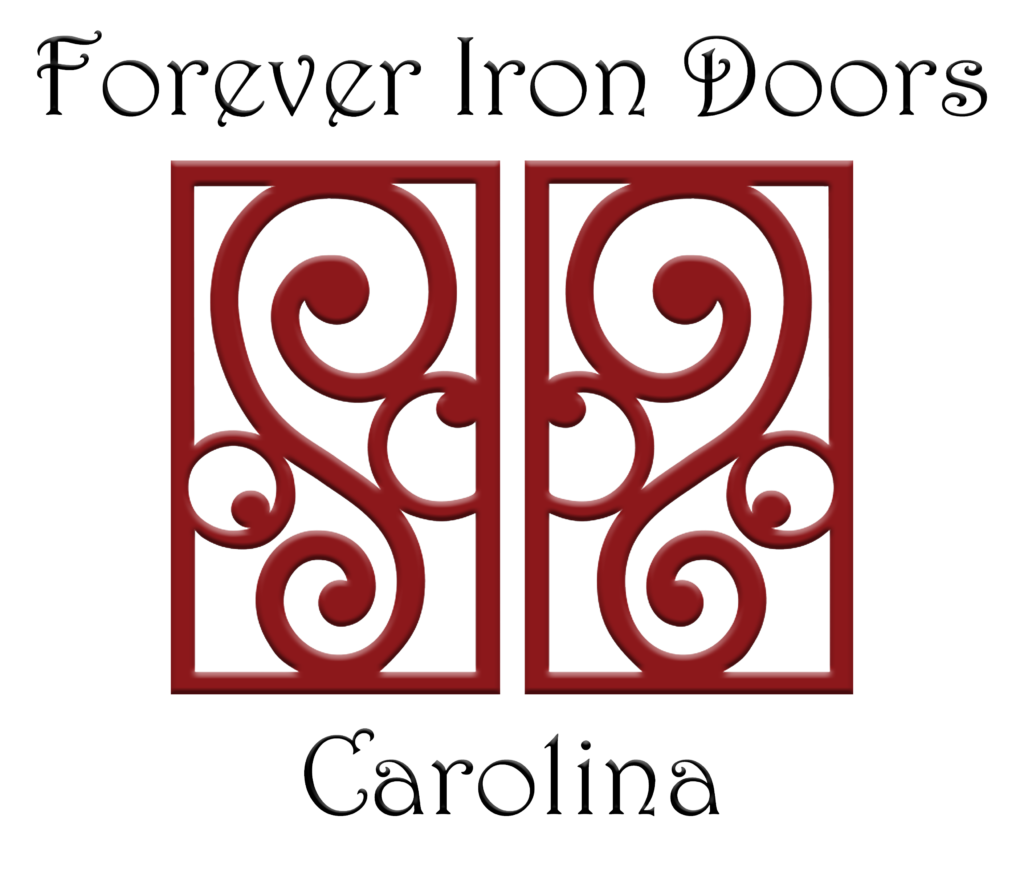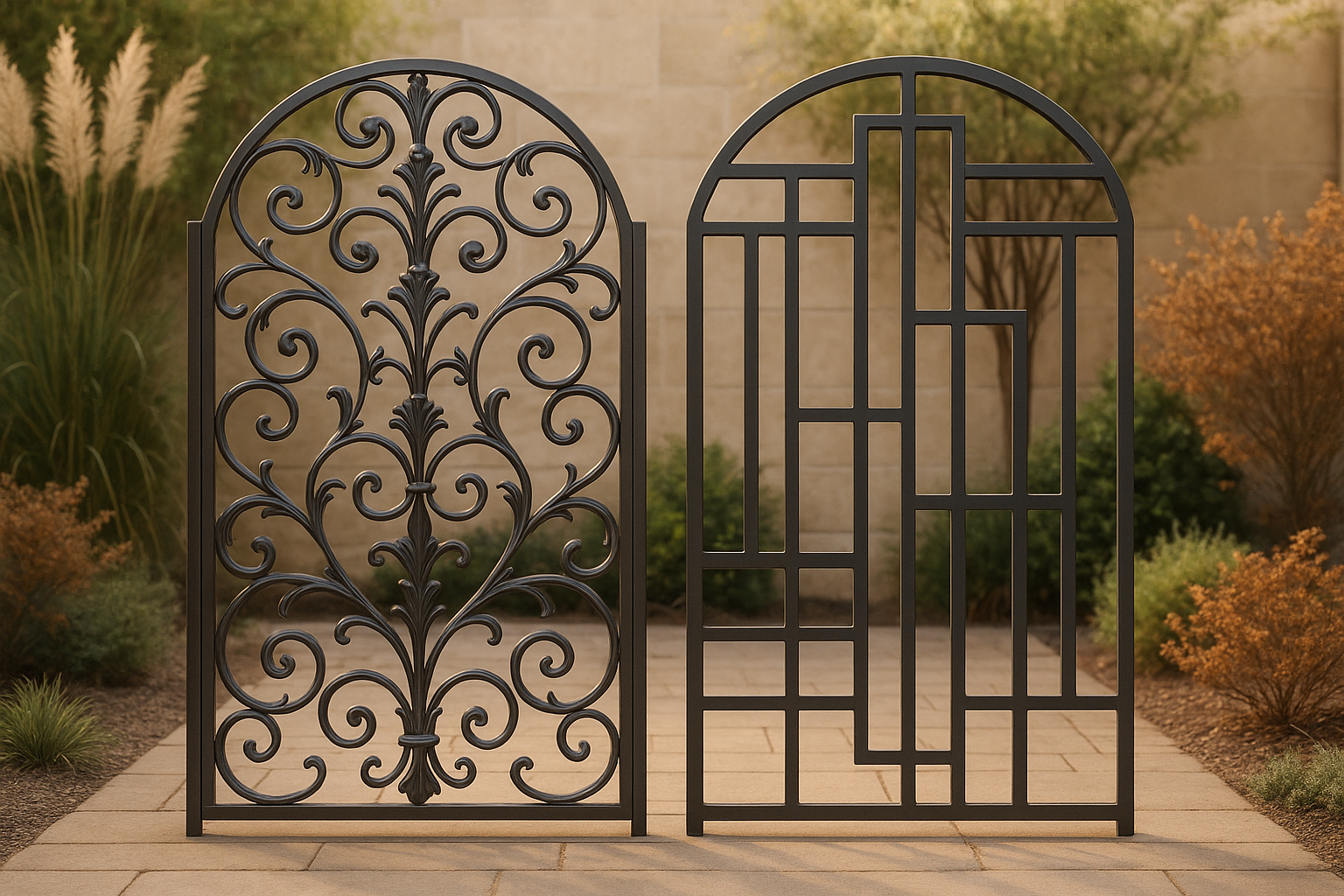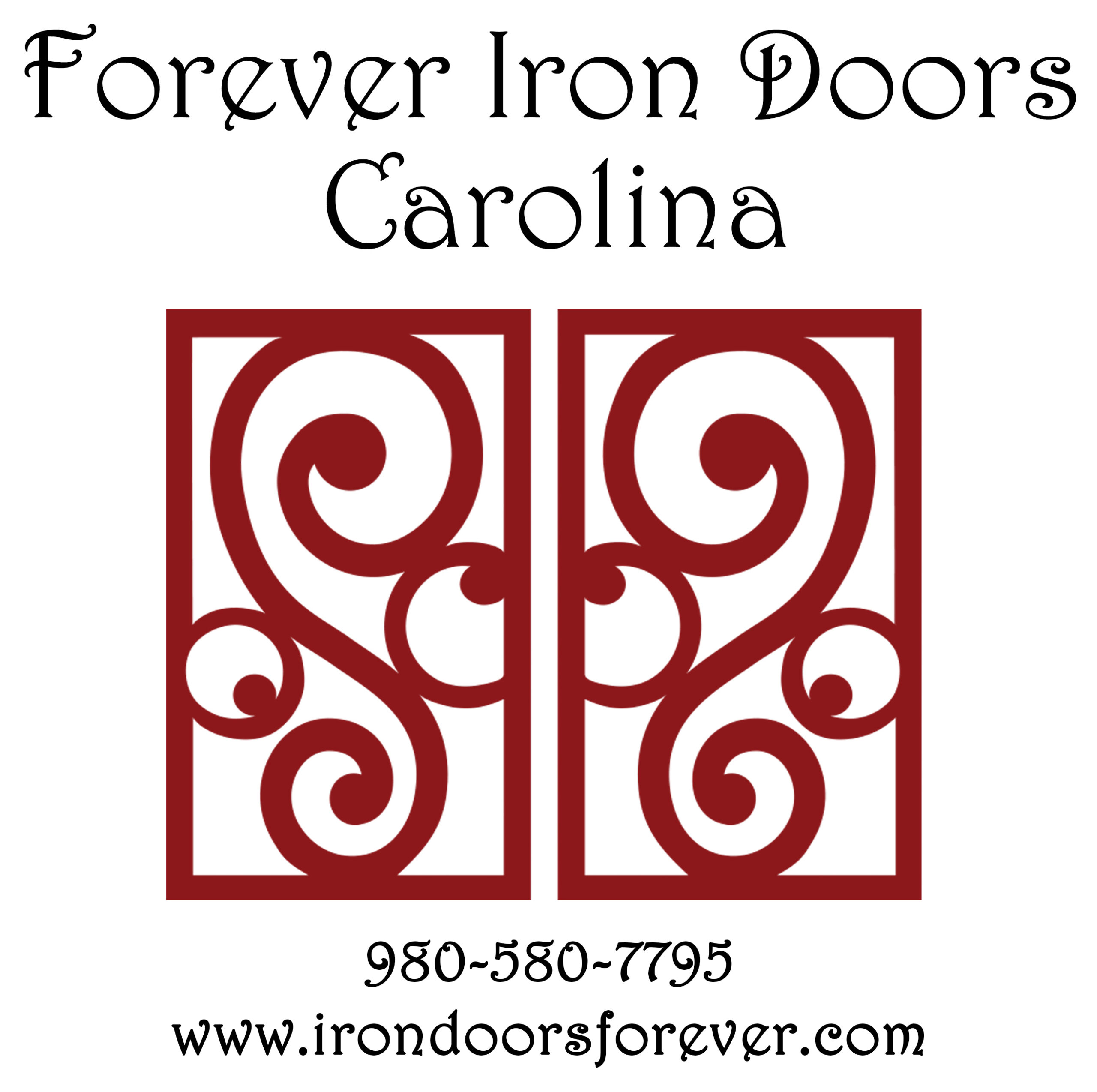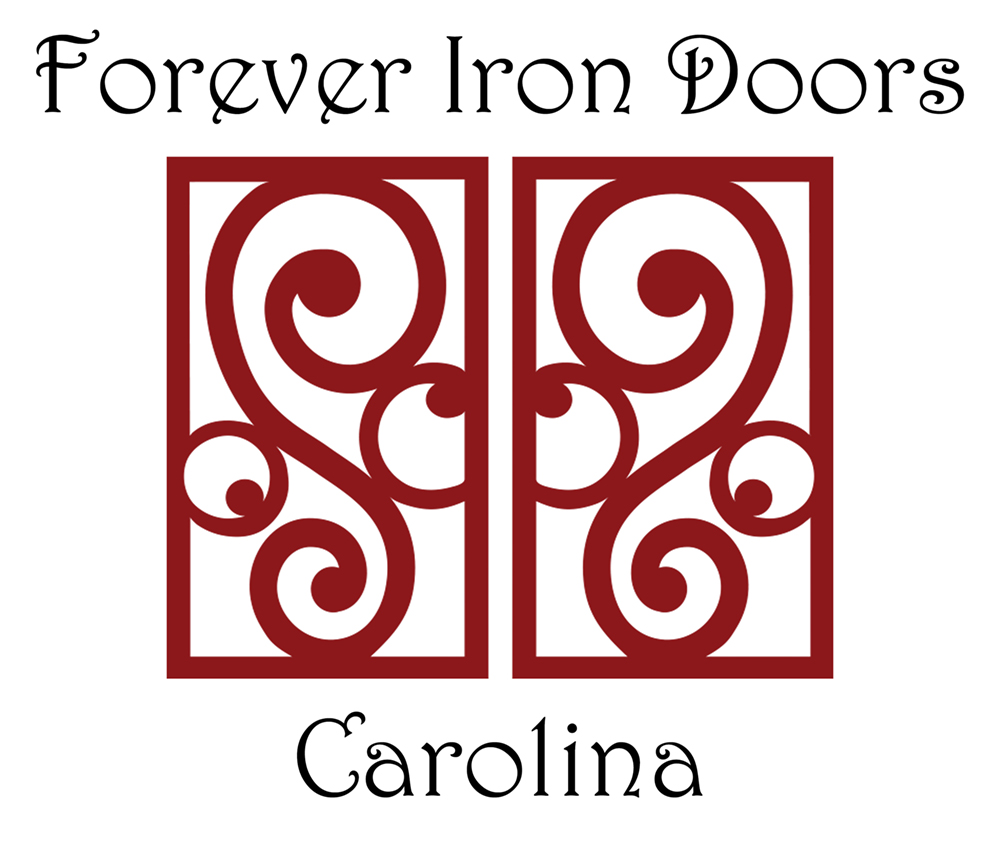Wrought iron doors combine durability with style, but choosing between classic and modern patterns depends on your home’s design and your personal taste. Here’s a quick breakdown:
- Classic Designs: Rich in scrollwork, floral motifs, and intricate details. Best for colonial, Mediterranean, or Tudor homes. Offers privacy but may require more maintenance.
- Modern Designs: Clean lines, geometric shapes, and open spaces. Perfect for minimalist or mid-century homes. Easier to maintain and allows more natural light.
Quick Comparison
| Feature | Classic Style | Modern Style |
|---|---|---|
| Motifs | Scrolls, florals, vines, rosettes | Straight lines, rectangles, circles |
| Glass | Textured or stained for privacy | Clear or frosted for openness |
| Finish Options | Antique bronze, patina effects | Matte black, custom powder coatings |
| Maintenance | More effort due to detailed designs | Easier with smooth surfaces |
| Best For | Traditional architecture | Contemporary and minimalist homes |
Both styles can be customized for durability, energy efficiency, and a perfect fit for your home. Your choice should reflect your home’s architecture, light preferences, and maintenance needs.
Classic Wrought Iron Patterns
Classic wrought iron patterns are a testament to centuries of craftsmanship, blending timeless beauty with modern functionality. These designs showcase the artistry and precision of blacksmiths, honed over generations, and bring a sense of elegance to any home.
Main Design Elements and Motifs
At the heart of classic wrought iron designs are intricate details and motifs that evoke both natural and architectural themes.
- Scrollwork: The defining feature of classic ironwork, scrolls are graceful spirals that create a sense of movement. Whether it’s the flowing curves of C-scrolls or the symmetrical elegance of S-scrolls, these elements often interweave to add depth and complexity.
- Floral Motifs: Nature finds its way into metal through beautifully crafted designs like acanthus leaves, inspired by ancient Greek and Roman architecture. Rose patterns offer a touch of romance, with petals carefully shaped to mimic real blooms, while vine patterns bring an organic flow, seamlessly connecting different parts of the design.
- Rosettes and Medallions: These decorative centerpieces, often circular or star-shaped, add dimension and serve as focal points. Layers of metalwork create striking shadows and textures.
- Twisted Bars: Adding texture and visual interest, these bars catch light in unique ways, enhancing the overall design.
- Geometric Balance: Symmetry and proportion play a big role in classic patterns. Many designs follow the golden ratio, creating harmony and a timeless appeal that has captivated the human eye for centuries.
These motifs are versatile and can be adapted to enhance various architectural styles, making them a popular choice for doors and entryways.
How Classic Designs Are Used
Classic wrought iron patterns shine in a variety of applications, particularly when paired with traditional architectural styles like colonial, Mediterranean, or Tudor.
- Double Doors: Symmetry is key here, with mirrored patterns that draw attention to the entrance. A central focal point often anchors the design, creating a grand and inviting look.
- Arched Doorways: The curved top of an arched doorway offers the perfect canvas for flowing scrollwork, while the rectangular lower section allows for more structured elements. This mix of curves and straight lines creates a balanced and visually pleasing design.
- Side Panels and Transoms: These elements extend the design beyond the door itself, scaling it to fit larger entryways while maintaining proportion. The seamless flow from door to surrounding panels creates a unified and elegant entrance.
What sets classic designs apart is their layered depth. Foreground elements like scrolls and floral motifs stand out against the background framework, creating a rich texture that shifts with the light throughout the day. This attention to detail ensures these designs command attention without overwhelming the overall aesthetic.
Classic patterns also integrate beautifully with a variety of architectural materials. For brick or stone facades, earth-toned finishes complement the natural textures, while stucco exteriors benefit from more intricate patterns that add interest to smooth surfaces.
Glass and Finish Options for Classic Styles
The choice of glass and finish can elevate classic wrought iron designs, adding personality and functionality to the overall look.
- Textured Glass: Options like seeded glass (with small bubbles for an antique feel), rain glass (with vertical streaks for a sense of movement), and Flemish glass (offering gentle distortion) enhance privacy while allowing light to filter through.
- Stained Glass Panels: These bring an artistic dimension to wrought iron doors. Amber and gold tones add warmth, perfect for Mediterranean or Tuscan-inspired homes, while deep blues and greens lend sophistication to colonial styles. The lead came construction of stained glass complements the handcrafted nature of wrought iron.
- Finish Options: The finish plays a crucial role in defining the door’s character.
- Oil-rubbed bronze provides a rich, aged look that develops even more character over time.
- Antique copper pairs beautifully with natural stone or brick exteriors, adding warmth.
- Custom powder-coated colors, like deep forest green, rich burgundy, or deep blue, allow the design to match specific architectural features.
- Patina effects, such as verdigris (mimicking aged copper) or weathered iron, add a sense of history and depth.
For a refined touch, pairing frosted glass with antique finishes offers privacy while softening light. This combination works particularly well in formal entryways, balancing elegance with practicality. Classic wrought iron patterns, when paired with thoughtful glass and finish choices, create an entrance that feels both grand and welcoming.
Contemporary Wrought Iron Patterns
Contemporary wrought iron patterns shift away from the elaborate details of traditional designs, focusing instead on clean lines and simplicity. This modern style creates entrances that feel both elegant and inviting by emphasizing essential forms and a streamlined structure.
Main Design Elements and Motifs
Unlike the intricate flourishes of classic wrought iron, contemporary designs prioritize simplicity. You’ll often find geometric shapes and clean, uncluttered lines that highlight both functionality and visual impact. This minimalist approach ensures a sleek, modern aesthetic.
How Contemporary Designs Are Used
These patterns are a perfect fit for modern architecture, particularly in spaces that celebrate minimalism and natural light. Contemporary wrought iron often incorporates large glass panels framed by minimal ironwork. This design choice not only secures the structure but also allows for an abundance of natural light, creating a seamless connection between indoor and outdoor spaces.
Glass and Finish Options for Contemporary Styles
Contemporary wrought iron doors and windows offer a variety of glass options to suit different needs. Clear glass provides an open, airy feel, while frosted or reeded glass offers privacy without sacrificing style. For added comfort, energy-efficient options like low-E or insulated glass help regulate indoor temperatures.
The finishes available for contemporary wrought iron further enhance its modern appeal. Powder-coated options, such as matte black, deep bronze, charcoal, or custom colors, provide durability and resist fading. To complete the look, hardware in finishes like satin nickel, oil-rubbed bronze, or matte black ensures both style and seamless functionality.
Direct Comparison of Classic and Contemporary Styles
When deciding between classic and contemporary wrought iron patterns, understanding their differences can help you choose a style that aligns with your home’s architecture and your personal preferences. Each style offers unique characteristics that cater to distinct aesthetic tastes and functional needs.
Below, you’ll find a breakdown of their design features and practical considerations to guide your decision.
Design Features Comparison Chart
Classic and contemporary wrought iron styles stand apart in their core design elements. Here’s a side-by-side comparison:
| Feature | Classic Style | Contemporary Style |
|---|---|---|
| Motifs | Scrollwork, florals, leaves, vines, ornate curves | Geometric shapes, straight lines, minimal patterns |
| Visual Balance | Dense, intricate details throughout | Clean, open spaces with selective accent elements |
| Negative Space | Limited open areas, filled with decorative elements | Generous use of open space for a modern aesthetic |
| Glass Integration | Smaller panels framed by elaborate ironwork | Large glass sections with minimal iron framing |
| Finish Options | Traditional black, antique bronze, aged patinas | Matte black, charcoal, custom powder-coated colors |
| Hardware Style | Ornate handles with decorative hinges | Sleek handles, hidden hinges, minimalist hardware |
This comparison highlights the distinct visual and structural choices each style offers. But design isn’t the only factor – practicality also plays a role.
Advantages and Disadvantages Chart
Both styles come with their own set of benefits and potential challenges. Here’s a closer look at how they stack up in terms of functionality and appeal:
| Aspect | Classic Style | Contemporary Style |
|---|---|---|
| Aesthetic Appeal | Pros: Timeless elegance, rich detail, traditional charm Cons: May feel outdated in modern settings |
Pros: Clean, modern look, versatile design, aligns with current trends Cons: May lack character in traditional homes |
| Privacy Level | Pros: Dense ironwork offers natural screening Cons: Limits natural light |
Pros: Glass options allow customizable privacy Cons: Large glass areas may need window treatments |
| Maintenance | Pros: Intricate details hide minor wear and scratches Cons: Can trap dust, requiring more cleaning effort |
Pros: Simple surfaces are easier to clean Cons: Smooth surfaces may show imperfections more easily |
| Design Flexibility | Pros: Complements period architecture and classic landscaping Cons: Less adaptable to modern home styles |
Pros: Blends well with a variety of architectural styles Cons: May clash with ornate or historical home designs |
| Cost Considerations | Pros: Established manufacturing methods Cons: Hand-forged details increase labor costs |
Pros: Streamlined production reduces complexity Cons: Custom powder coating can add to expenses |
The right style often depends on your home’s existing design. Classic wrought iron pairs beautifully with Colonial, Victorian, Mediterranean, and other traditional homes, enhancing their timeless charm. On the other hand, contemporary wrought iron suits modern, minimalist, ranch-style, and newly built homes, emphasizing clean lines and open spaces.
Think about how each style might influence your home’s curb appeal and resale value. Classic designs tend to hold broad appeal, attracting buyers who appreciate traditional elegance. Meanwhile, contemporary designs are ideal for those seeking a sleek, updated look that reflects modern trends.
sbb-itb-cd90297
Customization and Practical Factors
When choosing a wrought iron door, it’s essential to consider the practical aspects that influence its durability and overall satisfaction. By focusing on material quality, energy-efficient glass, and extensive customization options, you can ensure your door combines style with long-lasting functionality.
Materials and Long-Term Performance
The materials used in your wrought iron door play a major role in its ability to stand the test of time, especially in challenging climates like the humid Carolinas. High-grade steel with the right gauge, paired with a multi-step powder coating process, is key to resisting moisture and temperature fluctuations. A thicker gauge steel is particularly important for larger doors or those exposed to prolonged sunlight, as it minimizes the risk of warping.
The multi-step powder coating process involves meticulous surface preparation and color application, creating a protective barrier against rust while maintaining the door’s vibrant finish. For intricate designs, like traditional scrollwork, this process ensures every detail is coated to perfection. On the other hand, sleek, contemporary designs require a flawless, even application for a clean, polished look.
Glass Options and Energy Savings
The glass in your wrought iron door isn’t just for aesthetics – it also plays a big role in energy efficiency. Low-E (low-emissivity) glass, for example, has a special microscopic coating that reflects heat while still allowing natural light to brighten your space. This can help lower energy costs compared to standard glass options.
For even better temperature control, insulated glass units are a smart choice. These help reduce condensation and keep interiors comfortable, which is especially important in the Carolinas’ humid climate. If privacy is a concern, decorative glass options like frosted, reeded, or textured designs can strike the perfect balance between style and functionality.
Custom Options with Forever Iron Doors Carolina
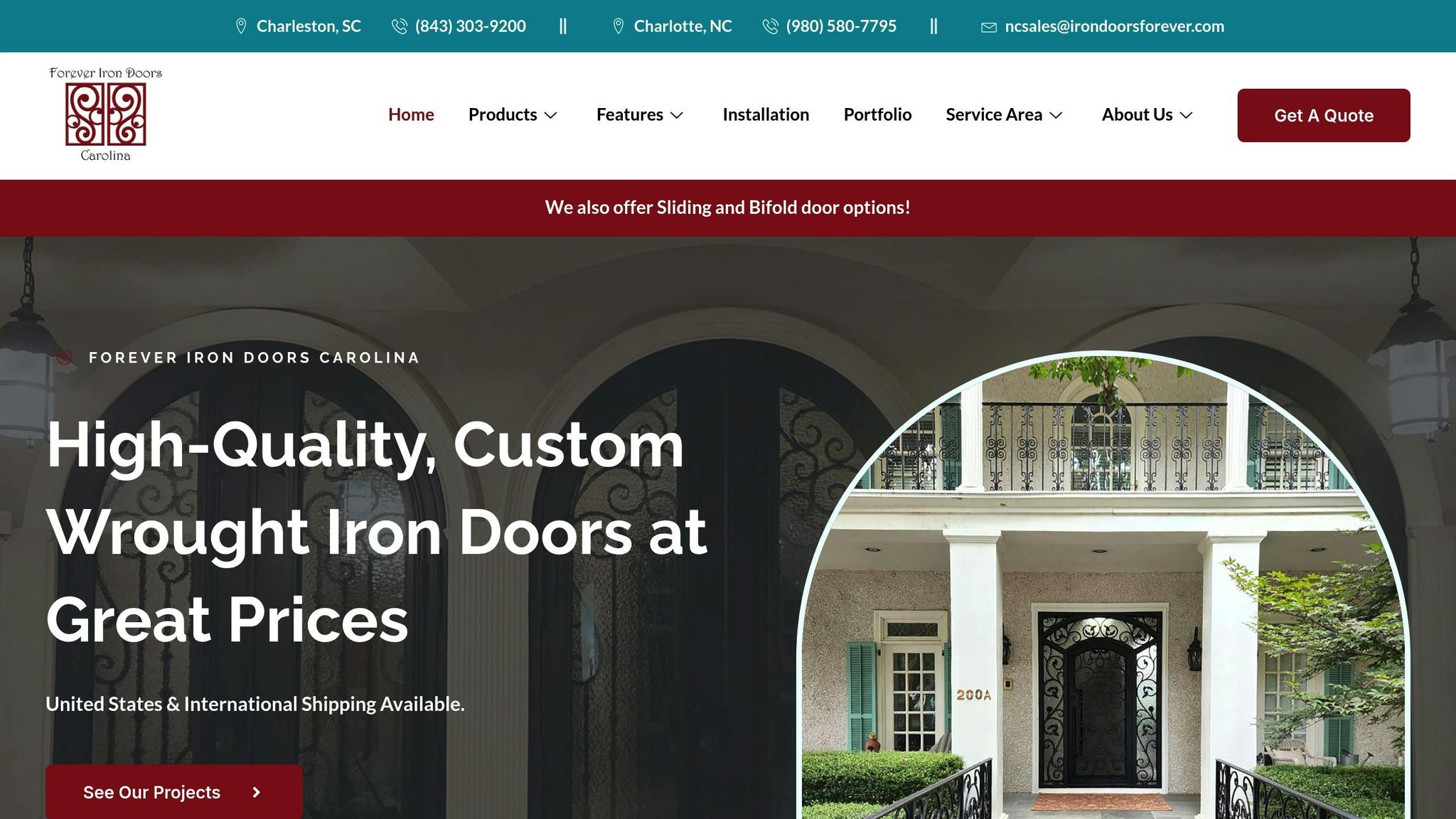
Forever Iron Doors Carolina offers a level of customization that makes it easy to achieve a door that perfectly matches your home’s architecture and your personal taste.
"With Forever Iron Doors Carolina, you won’t be choosing from a few limited templates. Instead, you’ll work with our design team to create a door that complements your architecture and fits your vision."
Their design process includes working with skilled artists who can craft custom wrought iron designs in any style, from sleek modern looks to ornate Renaissance-inspired patterns. Finish options go far beyond standard black, with choices like bronze, charcoal, and custom powder-coated colors designed to endure the Carolina weather. For a more distinctive touch, faux painting services can add effects like aged bronze, rust patina, or antique copper.
Hardware options are just as customizable, with a range of styles to suit any aesthetic. Choose from modern pulls, traditional handles, or rustic accents in finishes such as satin nickel, oil-rubbed bronze, or matte black. You can even add upgrades like automated locks or decorative handles for extra security and flair. The company also offers framing services to ensure your custom door integrates seamlessly with your home, even if it requires reframing for larger openings.
One satisfied customer, Matt V., shared his experience:
"Just got my new iron door. Door is amazing. Best place to do business. Very professional in every aspect. Jennifer designed an amazing door and Cory and his install team were fantastic and did an incredible job. I strongly recommend contacting them if you need a new door for your home."
This high level of customization ensures that homeowners can achieve their ideal look – whether it’s timeless elegance or sleek minimalism – while addressing practical needs like durability and energy efficiency. The result is a door that’s not just beautiful but also built to perform for years to come.
Choosing the Right Style for Your Home
Deciding between traditional and contemporary wrought iron designs comes down to your home’s overall aesthetic, your personal style, and practical considerations. Traditional patterns are known for their intricate details and timeless charm, while contemporary designs focus on clean lines, geometric shapes, and a minimalist vibe that feels sleek and modern.
The main difference lies in how each style complements different architectural themes. Contemporary designs are a natural fit for modern, transitional, and mid-century homes, where simplicity and functionality are key. Let’s dive into what you should weigh when making your choice.
What Homeowners Should Consider
Start by ensuring your door aligns with your home’s architectural features. Look at what’s already there – details like curved archways, decorative trims, or ornate fixtures tend to pair beautifully with traditional scrollwork. On the other hand, straight lines, expansive windows, and minimal ornamentation are better suited to contemporary geometric patterns.
Here are a few key factors to keep in mind:
- Light and privacy: Traditional designs often offer more privacy but can block natural light, while contemporary styles use larger glass panels to let in more light.
- Ease of maintenance: Intricate traditional scrollwork may require more effort to clean, whereas smooth, contemporary designs are typically easier to maintain.
- Longevity in style: Choose a design that resonates with your personal taste and fits your lifestyle for long-term satisfaction.
Making the Most of Custom Options
Customization opens up a world of possibilities, allowing you to blend styles for a design that feels just right. At Forever Iron Doors Carolina, you can create doors tailored to your home’s character and your functional needs. Instead of sticking strictly to traditional or modern styles, you might weave subtle traditional accents into a contemporary design or add modern flair to a classic look.
The design team works with you to address both practical and aesthetic needs. Whether you’re after enhanced security, energy-efficient glass, or finishes that complement your exterior, they’ve got you covered.
You can also personalize your door with custom hardware. For instance, traditional designs might feature ornate bronze fixtures with decorative backplates, while contemporary doors often lean toward sleek stainless steel or matte black hardware with simple, understated profiles.
Finally, professional framing ensures your door fits seamlessly into your home’s structure. This attention to detail not only boosts curb appeal but also adds value, making your door feel like an integral part of your home rather than an afterthought.
FAQs
How do I choose between traditional and modern wrought iron designs for my home?
When deciding between traditional and modern wrought iron designs, it’s essential to think about your home’s architectural style and the atmosphere you want to create. Traditional designs are known for their intricate scrollwork, floral motifs, and detailed craftsmanship. These elements bring a timeless elegance, making them ideal for classic or historic homes. In contrast, modern designs lean toward clean lines, geometric patterns, and a minimalist aesthetic, which pairs beautifully with contemporary or streamlined spaces.
It’s also worth considering how these styles will work with your home’s overall look and the design trends in your area. A growing number of homeowners are mixing traditional and modern elements to craft a distinctive, balanced style that offers the best of both worlds. Customization options – like adding glass panels, selecting unique finishes, or choosing specific hardware – make it easy to tailor wrought iron designs to your personal taste. With skilled craftsmanship, wrought iron doesn’t just enhance your home’s beauty but also boosts its security.
How do glass and finish options enhance the look and functionality of wrought iron doors?
When it comes to wrought iron doors, the glass and finish choices you make can significantly influence both their look and functionality. Glass options like clear, frosted, or textured glass each offer unique benefits. Clear glass lets in the most light, creating a bright and open feel. Frosted or textured glass, on the other hand, strikes a balance by adding privacy while still allowing natural light to filter through – perfect for a welcoming yet private entryway.
The finish you choose does more than just define the door’s style; it plays a big role in its durability. Protective finishes like powder coating or galvanization guard against rust and weather damage, ensuring the door stays strong and beautiful over time. From matte to glossy to antique, the finish can complement anything from a sleek, modern aesthetic to a more classic, timeless look.
By carefully selecting the right combination of glass and finish, you can enhance the security, style, and longevity of a wrought iron door, making it a standout feature for any home or business.
Can I design a wrought iron door that combines both traditional and modern styles to match my home’s look?
Wrought iron doors offer the perfect canvas for blending traditional charm with modern simplicity, resulting in a look that aligns seamlessly with your home’s architectural style. Imagine intricate scrollwork or floral motifs inspired by classic designs paired with sleek, geometric shapes or minimalist accents from modern trends. The result? A door that feels both timeless and current.
You can take the customization further with choices like different glass styles, finishes, and hardware. These options allow you to create a door that strikes a harmonious balance between classic beauty and modern flair, boosting your home’s curb appeal while showcasing your personal taste in a way that’s truly one-of-a-kind.
